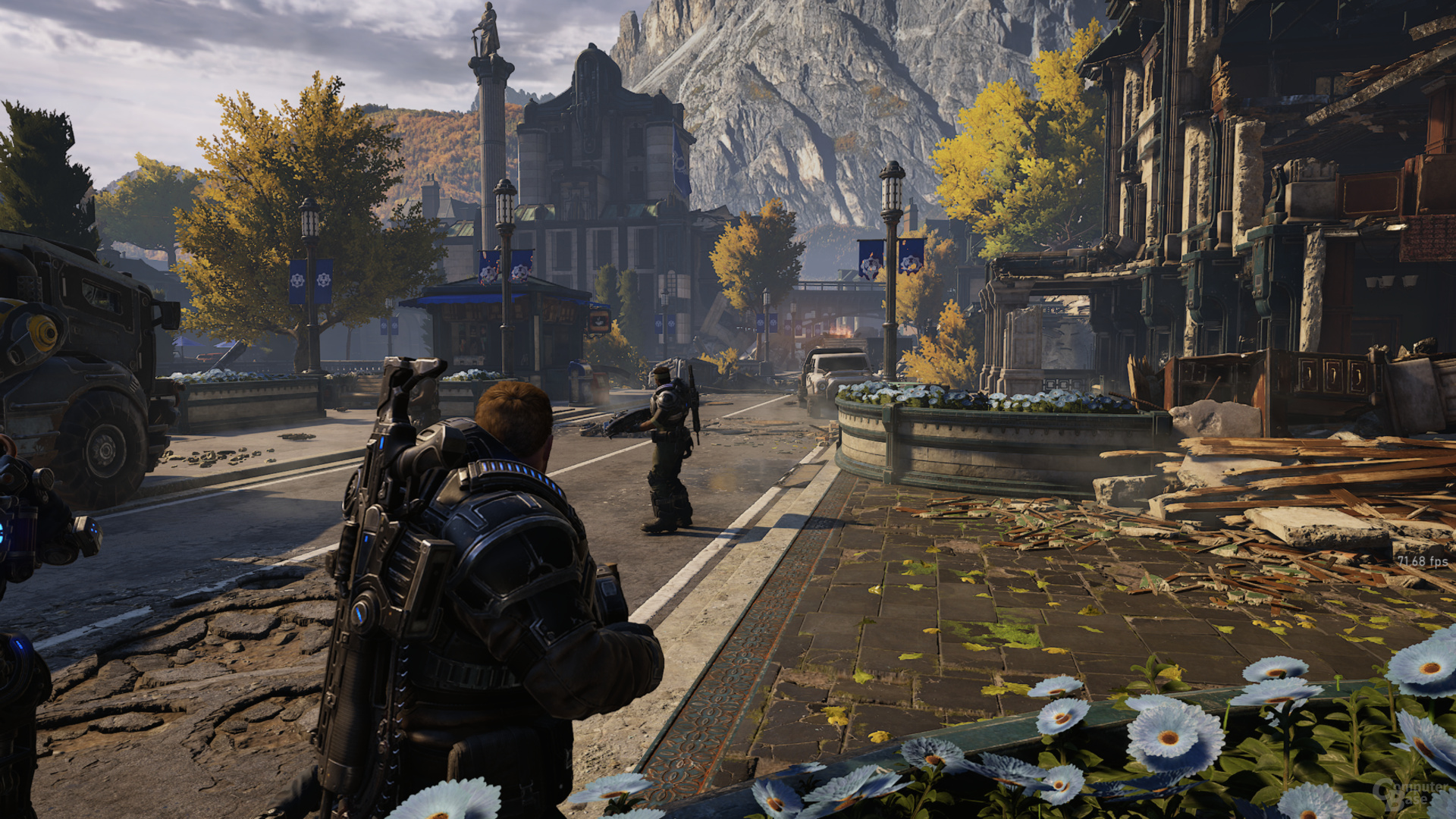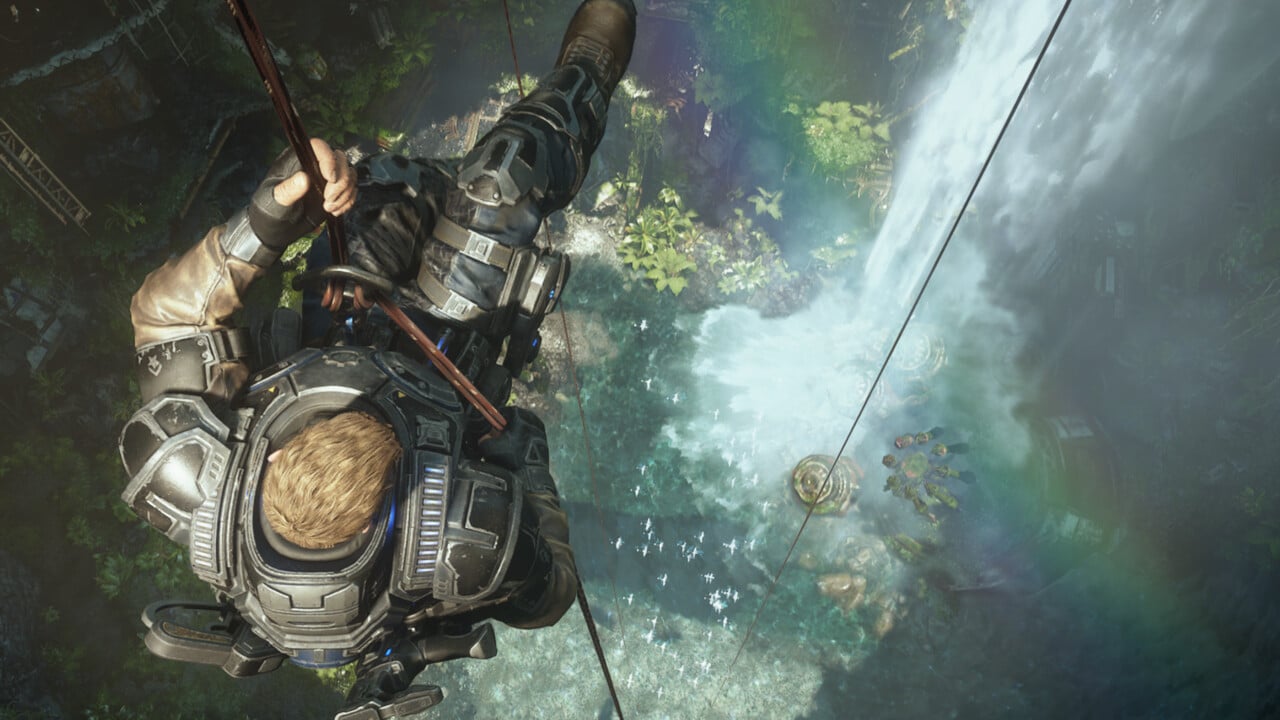– Gears of War enters the fifth round. The game, which is only called Gears 5, scores with a chic graphics and a good implementation of DirectX 12. It does without UWP. Benchmarks show that an appropriately fast graphics card is required for maximum graphics. But there is a lot of tuning potential.
The latest installment in the Gears of War game series is just around the corner. Buyers of the 79.99 euro Ultimate Edition can play from Friday, September 6th. All others from next Tuesday, September 10th. The fifth part is only called Gears 5 – “of War” is history. The game itself is still strongly based on the predecessor, but it does everything better: Both the content and the technology of the PC version know how to please in the test.
Good graphics with DirectX 12 and without UWP
Gears 5 offers consistently good graphics. The lighting is at a high level, the characters look good, the particle effects provide a lot of dynamism on the screen, the environment always falls into pieces and there is actually always something going on. In short: Gears 5 is quite a graphic fireworks display that lacks the breathtaking highlights, but also real weaknesses. The overall impression is very consistent.
The developer The Coalition relies on the Unreal Engine 4 as in the previous part, but there have been some improvements graphically. What has remained the same, however, is that Gears 5 only uses the low-level API DirectX 12 on the PC. If you think of Microsoft’s Windows 10-exclusive UWP platform with horror, you can be reassured: Gears 5 is also sold through the Windows Store, but it is a classic Win-32 application and not a UWP title , whose numerous disadvantages are eliminated. There are two more premieres: Gears can also be bought on Steam and played on Windows 7 – despite DirectX 12.
The PC version of Gears 5 was created in close collaboration with AMD. Apparently, however, no customized graphics features made it into the game. Instead, AMD wants to have helped with the integration of “Asynchronous Compute” and FidelityFX in the form of a focus filter is also included – the latter, however, only with a future patch. According to AMD, the cooperation between the game, Ryzen processor and Radeon graphics card has been optimized.
The graphics menu is in no way inferior to the graphics. Actually only sample screenshots are missing, apart from that almost every conceivable option is available. This starts with numerous graphics options, all of which come with an explanation, and extends to the information on how much the option loads the processor, the graphics card or the graphics card memory.
Two FPS limiters, upsampling and downsampling as well as an AO slider
Gears 5 offers an FPS limiter – or actually two. The normal, switchable limiter can be configured relatively freely with 30, 60, 90, 120 and 144 FPS. There is also a variant that only applies to the cutscenes and can be switched off or alternatively set to 30 FPS. However, if you want to hold a minimum number of images per second, you can use the “Minimum frame rate” option. Then, depending on the scene, the graphics quality is dynamically reduced in order to keep at least 30, 60 or 90 FPS.
Both upsampling and downsampling can be set in the options menu. The available settings vary depending on the native screen resolution. On an Ultra HD monitor, the minimum internal resolution is 1,280 × 720 pixels (11 percent of the native resolution) and the maximum 4,480 × 2,520 pixels (136 percent).
The menu also offers settings that are otherwise rare. Not only can the quality of the surrounding cover be adjusted, but the thickness of the “ambient occlusion” can also be adjusted according to your own taste. There is also a slider for the intensity of motion blur.
Async compute and tiled resources can be configured
If the graphics card also offers the feature level of DirectX 12 (Maxwell 2.0, Pascal, Turing, Vega, Navi), the “Tiled Resources” item can be switched on and off in the options menu. This is supposed to improve the texture streaming in the game. “Async Compute” can also be configured. The feature is offered at least in the options menu but only when using an AMD graphics card. At Nvidia, the menu item is missing even on Turing, although the architecture usually and in contrast to Pascal benefits from it. It remains unclear at the moment whether “Async Compute” is actually deactivated on an Nvidia GPU. There are benchmarks for both points on the next page.
In the game there is the possibility to overlay the frame rate. If that’s not enough for you, you can also display frame times and some other information. If you have problems with the game, you can activate the “Diagnostic mode” in the graphics menu. Then information about the condition is logged in a file, which can be helpful in troubleshooting.
Four graphic presets and good anti-aliasing with sharpness slider
Gears 5 has four different graphic presets with “Ultra”, “High”, “Medium” and “Low”, whereby “Ultra” does not represent the maximum graphic details. The menu items “Animation quality”, “Dynamic shadow quality”, “Quality of the volumetric fog” and “Surface reflections” can be increased to “Best” or “Insane”.
Every preset has visible effects. If you use “Ultra” instead of the maximum possible details, you have to be satisfied with a surrounding covering that does not or only partially processes some surfaces. In addition, the ultra reflections look like direct reflection of a flat surface. However, if the reflections are set to the highest level, they appear significantly more diffuse, as with a rather rough surface. This looks much more realistic on the materials used.

The high preset then completely switches off many reflections, the same applies to the surrounding masking. Less tessellation is used, which reduces surface details. And less details are shown at medium to high distances. “High” is still the last preset that still looks appealing.
From the middle preset, there is the problem that the LOD works very aggressively and objects keep appearing in front of the player. In addition, many objects are no longer displayed at medium to large distances and the textures are washed out. Meanwhile, with the low preset, Gears 5 becomes ugly in almost every way.
Graphics presets in Gears 5
- Low-Preset
- Central Preset
- High-Preset
- Ultra-Preset
- Maximum details
Those who do without the maximum details and switch back to the ultra preset will get a performance boost of 15 percent on the Radeon RX 5700 XT, and even 22 percent on the GeForce RTX 2070. It is rare that there are major differences between an AMD and an Nvidia graphics card at different levels of detail.
If you use the still highly usable high preset, you get a noticeable additional jump of 33 or 22 percent. Here the picture suddenly turns and the combined difference between maximum and high details hardly differs between a GeForce and a Radeon. The middle preset then brings another 20 and 21 percent more FPS, the ugly level “low” accelerates the game by another 50 percent.
A neat edge smoothing with sharpness of your choice
The anti-aliasing in Gears 5 cannot be deactivated. That’s a good thing, because she works properly. In Full HD, only a few surfaces flicker, from WQHD the picture is then largely flicker-free. A little time should be invested in the menu item “Sharpening”. This sharpens the image and is configured very reserved by default. This helps the picture calm, but hardly the sharpness. If you sharpen with higher values, hardly anything changes, but the picture appears visibly clearer.
With “+25” in 2,560 × 1,440, the editors liked a very aggressive setting, since even then there was hardly any flickering, but the image was free from any blurring. The menu item must be configured according to your own requirements.
Good textures want 8 GB of graphics memory
Gears 5 has consistently good, if not groundbreaking, textures. However, the memory consumption is not exceptionally high – an 8 GB graphics card is also sufficient for Ultra HD. 6 GB is sufficient for lower resolutions. With 4 GB, however, the texture details should be reduced.
Speaking of texture details: The ultra textures can be set in the options menu, but they have to be downloaded at least partially manually. A mouse click on the corresponding item in the menu is actually sufficient. However, because the download is only a few hundred megabytes, this way seems cumbersome.
A “UWP peculiarity” has remained
Gears 5 is no longer a UWP game. A peculiarity that all previous UWP games had, however, still exists and is expressed as follows:
If Gears 5 renders at the same resolution that was set on the Windows desktop, everything is fine. If you let the game render with a different resolution, VSync can be switched off correctly, but image synchronization still takes place. The graphics card then renders the frames as quickly as possible, but Windows occasionally discards frames to only output images without tearing.
Of course, that’s optically more beautiful. At frame rates below the refresh rate of the monitor, however, there can be an unsightly stall. This is easy to notice on 60 Hz displays and is annoying. Therefore, Gears 5 should only ever render at the resolution set on the Windows desktop. However, the internal downsampling and upsampling cannot be used meaningfully.
On the next page: GPU benchmarks, frame times, Async Compute and Co
















